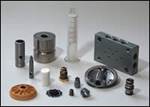Hone In On A Honing Method For Your Application
Like many metalworking processes, there are several machining methods for honing operations, and knowing which one is best for your particular application is critical for finding efficiency and cost effectiveness for your shop.
Like many metalworking processes, there are several machining methods for honing operations, and knowing which one is best for your particular application is critical for finding efficiency and cost effectiveness for your shop.
What is honing? Honing is a secondary operation used to improve the geometric form of a bore. A rotating tool, using either a diamond-coated sleeve or stone abrasive, is used to remove metal from an interior surface to create a specific diameter and cylindricity. The length of stroke and the size of the abrasive give honing the advantage over internal grinding for workpieces with a length-to-diameter ratio of 2 to 1 or more. The tool and the abrasive itself determine the accuracy of the operation, often within tolerances of 0.000040 inch.
Three popular machining methods are used for honing operations, available in both horizontal (for small and lightweight workpieces) and vertical designs (for large diameter, heavy parts):
• Multistroke machines have one or more abrasive stones attached to a single rotating spindle. This process is able to remove material quickly while providing highly accurate finish diameter, cylindricity and surface finish. It works well in parts used for bearing surfaces, particularly for needle and roller bearings.
• Single-stroke honing uses a tapered arbor assembled with a sleeve plated with an abrasive. The tool hones the bore by positioning the tapered sleeve, and in a single stroke, sizes the bore to a predetermined diameter.
• Krossgrinding is a process that uses a split tubular design with a plated diamond abrasive on the outer surface and a tapered inside surface. A wedge is precisely moved inside the tool to expand the plated diamond abrasive. To read more about the advantages of the Krossgrinding honing method, see “Expanding On Honing Options”.
Other types of honing delivery include multi-spindle honing systems and precision bore machining.
To send article ideas for this column relating to metalworking processes, please e-mail me at lbeckman@productionmachining.com. I look forward to hearing from you.
Related Content
-
The Ins and Outs of Inserts
Understanding how inserts are made provides valuable insight into how their performance can be optimized.
-
The Value of Tool Monitoring on Rotary Transfer Machines
By using a tool monitoring system, shops can save costs associated with machine maintenance and downtime for tool changes while increasing cutting performance.
-
Tool Path Improves Chip Management for Swiss-Type Lathes
This simple change to a Swiss-type turning machine’s tool path can dramatically improve its ability to manage chips.













.png;maxWidth=300;quality=90)


